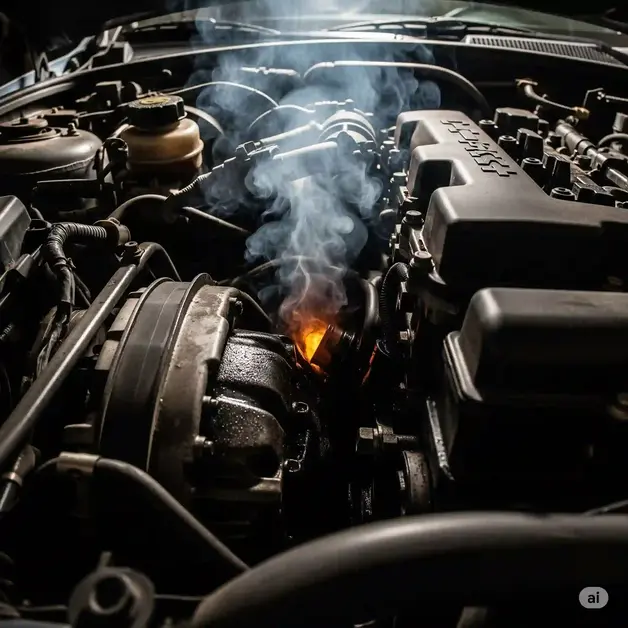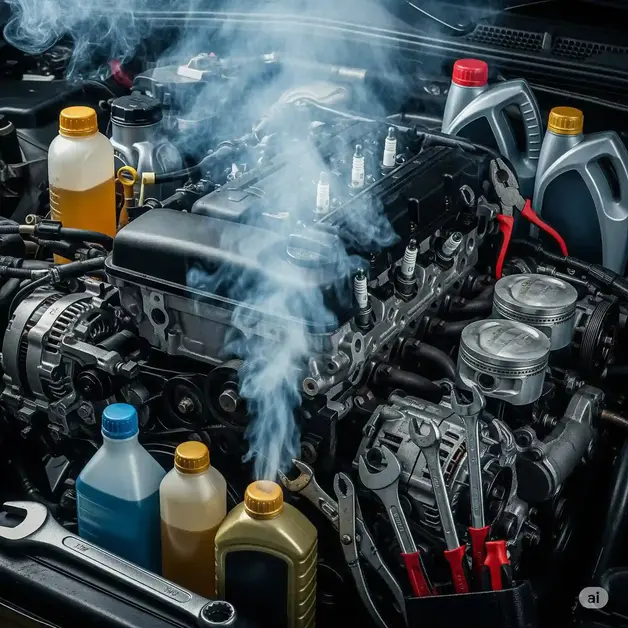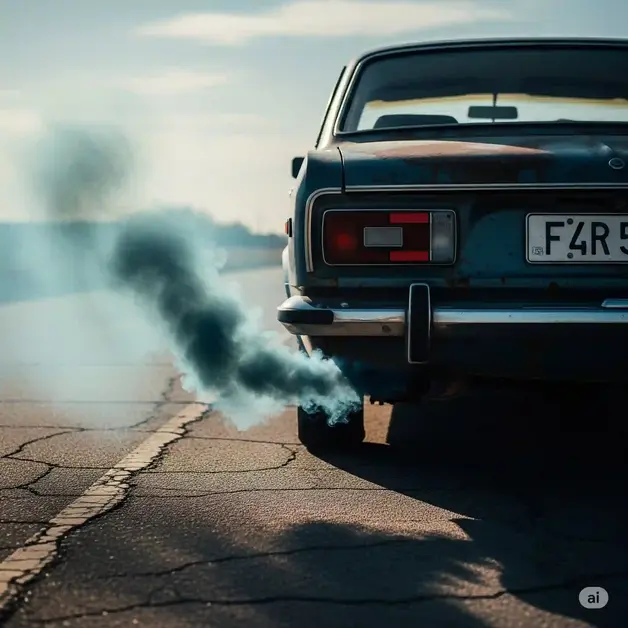I used to think my car was fine—until one morning I saw bluish smoke in my rearview mirror and caught that sharp, burnt smell. Yep, my car was burning oil, and I had no clue what that meant at first. If you’ve asked yourself, “Why is my car burning oil?” or noticed your car smells like burning oil, you’re definitely not alone. I’ve been through this, and after weeks of oil top-offs, research, and garage visits, I figured out what was going on.
In this article, I’ll walk you through what I learned the hard way—from spotting the early signs to understanding engine burning oil issues and how I finally fixed mine. Whether you’re dealing with excessive oil consumption or just curious why cars burn oil at all, this guide is for you. Let’s break it down simply and get your motor running smoothly again.
What Does It Mean When Your Car Is Burning Oil?
If your car is burning oil, it means oil is leaking into the combustion chamber where it burns along with fuel. This can cause blue or gray smoke from your exhaust, a burnt oil smell, and rapid oil loss without visible leaks. Ignoring these signs can cause serious engine damage.
Common Causes of Burning Oil:
- Worn Piston Rings
- Damaged Valve Seals
- Clogged PCV Valve
- Incorrect Oil Type or Overfill
Car Burning Oil Symptoms
-
🔹 Blue smoke from exhaust
-
🔹 Frequent low oil level
-
🔹 Burning oil smell
-
🔹 Fouled spark plugs
-
🔹 Engine misfiring or rough idling
-
🔹 Oil consumption between chang
What I Noticed First — Signs Your Car Is Burning Oil
The first sign hit me on the way to work. I glanced in the rearview mirror and saw blue-gray smoke curling out of the exhaust. I thought it was just morning fog or maybe some leftover moisture. But no—this was different. It had a thick, oily look to it. And worse? It smelled like something was cooking, in a bad way.
If your car smells like burning oil, especially when you’re stopped at a light or idling in traffic, don’t ignore it. That smell is oil hitting hot engine parts or getting burned in the combustion chamber. It’s like burnt toast, but with a metallic twist. Not pleasant—and not normal.
Another red flag? I had to top off the oil more often than usual. I’d just changed it, and a few hundred miles later, the dipstick was low again. No puddles under the car. No visible leaks. But the oil kept disappearing. That’s when it clicked: my engine was burning oil, not leaking it.
Soon after, the oil light started flickering on the dash earlier than it should. At first, I brushed it off. Big mistake. That little light was the engine’s way of waving a red flag at me. Combined with the smell and the smoke, it confirmed something deeper was wrong.
I also noticed the engine felt rough, especially when starting up. A couple of times, it even misfired. It didn’t sound like the smooth hum I was used to—it coughed, stuttered, then settled. If your car does that, don’t wait. Oil burning can mess with spark plugs and cause ignition problems fast.
For me, it all started small—just a smell and a little smoke. But those first signs helped me catch the problem early. If your car smells like burning oil, or your oil level keeps dropping without a leak, trust your gut. Something’s not right under the hood.
Why Is My Car Burning Oil? (Real Causes Explained Simply)
So, why is your car burning oil in the first place? That’s what I kept asking myself as I topped off the dipstick for the third time in a week. No puddles, no visible leaks—just oil disappearing into thin air.
Turns out, several things can cause it. I learned them the hard way, through long chats with my mechanic and a lot of messy DIY. Let’s go over the main ones—quickly and simply.
1. Worn Piston Rings
This was the big one for me. Piston rings are supposed to keep oil out of the combustion chamber. When they wear down—usually from age or overheating—they let oil sneak in and burn with fuel.
If you’re seeing blue smoke from the exhaust, especially when accelerating, your piston rings may be worn.
My mechanic showed me the inside of a cylinder with a scope—carbon buildup and oily residue everywhere. That was my clue.
2. Failing Valve Seals
Valve seals keep oil from dripping into the engine when it’s off. But when they wear out—especially in older cars—you’ll notice smoke during startup, often after the car’s been sitting overnight.
Blue smoke during a cold start is often a sign of bad valve seals.
In my case, this came second. Replacing them stopped the morning smoke.
3. Blown Head Gasket
This one’s serious. A blown head gasket lets oil (and sometimes coolant) leak into the combustion chamber. You’ll usually see overheating, smoke, and maybe even milky oil.
If your engine is overheating and losing both coolant and oil, you might have a blown head gasket.
Luckily, mine wasn’t blown—but it was one of the first things the shop checked.
4. Clogged or Bad PCV Valve
The PCV valve regulates pressure inside the engine. If it clogs, oil can get pushed into the combustion chamber or out through seals—causing both burning and leaks.
If there’s no leak but your oil keeps vanishing, check the PCV valve. It’s cheap and easy to replace.
This was my first fix. A $15 part made a noticeable difference.
5. Wrong Oil Grade or Old Oil
Using oil that’s too thin in an older engine? Recipe for burning. I was using a 5W-20 because that’s what the shop added, but my engine had over 160,000 miles. Thin oil just slipped past the worn seals.
High-mileage engines often need thicker oil to prevent burning.
Switching to 10W-30 high-mileage oil reduced my top-offs and kept the engine running smoother.
6. Overheating Engine
Heat breaks everything down faster. When your engine runs too hot, oil thins out and can’t protect as well. That leads to wear, leaks, and—you guessed it—burning.
If your temp gauge runs high, fix it fast or expect oil burning to follow.
A stuck thermostat caused my temp to spike. Fixing that slowed the burn too.
How I Narrowed It Down
For me, it wasn’t just one issue. Worn rings and a clogged PCV valve were the main problems. My mechanic confirmed it with a compression test. I tackled the cheap stuff first—like oil grade and PCV valve—then worked up to the piston ring rebuild.
If you’re not sure what’s causing your car to burn oil, start simple and get a mechanic to run a compression or leak-down test.
Trust me, catching it early makes all the difference.
How Much Oil Is Too Much? Understanding Excessive Oil Consumption
I used to think needing a little extra oil between changes was normal. After all, cars aren’t perfect, right? But when I found myself topping up every 500 miles, something didn’t sit right. That’s when I started digging into what’s actually considered “normal” oil use—and what’s a red flag.
Short answer: Most cars shouldn’t burn more than a quart of oil every 1,000 to 1,500 miles. If you’re adding oil more often, it’s likely excessive.
What’s “Normal” Oil Usage vs What’s Not
Believe it or not, some oil consumption is considered normal—especially in older engines or high-mileage vehicles. Many automakers even admit their engines can burn up to a quart every 1,000 miles without it being a “problem.” But that doesn’t mean it’s healthy. My car used to go 4,000 miles between oil changes without a hitch. When that dropped to 800, I knew something had changed.
Short answer: While some oil burn is normal, a sudden increase or drop below 1,000 miles per quart is worth investigating.
What My Mechanic Told Me When I Was Topping Up Every 500 Miles
I remember walking into the shop holding a fresh quart of oil like it was my new best friend. I told my mechanic I was going through one every other week. He raised an eyebrow and said, “That’s not just consumption—that’s loss.” That stuck with me. He explained that excessive oil consumption can point to internal leaks, bad seals, or worse. And if you ignore it? You’re slowly starving your engine.
Short answer: Using a quart every 500 miles is not normal. It often means your engine is burning oil or there’s an internal issue.
When It’s Time to Worry: Key Warning Signs
Here’s what tipped me off that my car had crossed the line from “normal” to “excessive” oil use:
- Blue smoke from the tailpipe (especially during acceleration or startup)
- Oil light flickering between changes
- Smell of burnt oil even with no visible leak
- Dipstick reading low a week after a full top-up
- Engine feeling rough or hesitating at idle
If you’re seeing two or more of these? That’s your car begging for help.
Short answer: Blue smoke, burnt oil smell, low dipstick readings, and rough idles are signs your engine is consuming too much oil.
Real-World Stats: OEMs vs Real-Life Cases
Manufacturers like BMW and Subaru have been known to say that burning a quart every 800–1,200 miles is “within spec.” But most everyday drivers—and mechanics—know that’s not ideal. Engines that are well-sealed and maintained shouldn’t lose more than a quart every 2,000–3,000 miles. If your car is burning oil at half that rate, it’s not just wearing out—it’s waving a warning flag.
Short answer: Even if your car’s manual says oil loss is “normal,” frequent top-ups under 1,000 miles are usually a sign of engine wear or damage.
For me, excessive oil consumption was the wake-up call. I thought I could ignore it or keep adding oil until my next service. But every time I put it off, I risked long-term damage. Once I understood what “too much” oil loss looked like, I knew I had to fix the root issue—not just band-aid it.
Car Smells Like Burning Oil? Here’s What That Means
One of the first things I noticed—before any smoke, misfires, or lights—was that sharp, nasty smell. I was sitting at a red light, windows cracked, and boom—there it was. A thick, burnt, almost metallic odor creeping in. Not gas. Not exhaust. Something different. That’s when it hit me: my car smells like burning oil.
Short answer: If your car smells like burning oil, it’s likely leaking onto hot engine parts or burning inside the combustion chamber.
Why That Strong, Smoky Smell Matters
This isn’t just a weird scent you can ignore. It’s a warning. When oil gets where it shouldn’t—like on the exhaust manifold or near a hot engine block—it cooks. And the smell is your early alert system. No dashboard light, no beeping—just your nose doing detective work.
Short answer: A burnt oil smell is often your first sign that something is leaking or burning under the hood.
If you can smell it, your engine can feel it. Trust your nose.
Where Oil Might Be Leaking onto Hot Parts
In my case, it turned out the valve cover gasket had a slow leak. Nothing was dripping onto the ground, so I figured I was safe. Nope. The oil was seeping out just enough to land on the hot exhaust parts—and that’s where the smell was coming from.
Short answer: Oil leaking onto the exhaust or engine block causes that hot, smoky smell—especially at stops or low speeds.
It doesn’t take much. A few drops of hot metal and boom—your cabin smells like a fried engine. The smell was strongest after driving a while, especially in traffic. That’s a clue it’s a heat-related issue.
Smell vs Smoke: Which One Showed Up First for Me
The smell came before the smoke in my case. Weeks before I saw that blue haze in the mirror, I was smelling burnt oil. At first, it was faint. I actually thought it might be another car. But as days passed, it got stronger. Eventually, the smoke confirmed it.
Short answer: If your car smells like burning oil but you don’t see smoke yet, you may have caught the issue early—don’t ignore it.
Your nose often knows before your eyes do.
When Smell Alone Signals Engine Damage
Here’s the part that surprised me. I thought the smell alone wasn’t a big deal—maybe just a seal or a gasket. But my mechanic said that even without visible smoke, a burnt oil smell can mean oil is getting into the combustion chamber. That’s a sign something internal might be wrong—like valve seals or piston rings starting to fail.
Short answer: A persistent burnt oil smell can point to internal engine damage, even if there’s no smoke—get it checked before it gets worse.
For me, it wasn’t just about the smell anymore. It was about catching the problem before it turned into a full-blown repair bill.
If your car smells like burning oil—even just once—take it seriously. Pop the hood. Check the dipstick. Look for oil stains or wet spots near the valve cover or around the exhaust. It might not look dramatic yet, but your engine could be trying to tell you something important.
How I Stopped My Engine from Burning Oil
Stopping my car from burning oil wasn’t some overnight fix. It took trial, error, and more than a few Saturday mornings under the hood. I didn’t want to just keep topping off oil and hoping for the best. I wanted the problem gone. So I tackled it step by step—starting small and working my way up.
Short answer: Fixing engine oil burning often requires a mix of maintenance, upgrades, and part replacements—starting with the simplest.
Replacing the PCV Valve — Cheap and Easy
This was my first move—and honestly, I wish I’d done it sooner. The PCV valve helps relieve pressure inside the engine and reroute oil vapors properly. When it clogs or sticks, oil can get pushed into places it doesn’t belong, like the combustion chamber.
Short answer: A clogged PCV valve can cause oil to burn by increasing pressure inside the engine—it’s a quick and low-cost fix.
I swapped mine out with a $12 part in under 30 minutes using just a socket wrench. After that, the oil loss slowed down noticeably. Not gone, but better.
Switching to High-Mileage Synthetic Oil
Next, I changed the oil—and not just any oil. I switched to a high-mileage synthetic blend made for engines over 100k miles. These oils have additives that help condition seals and reduce oil burn, especially in older engines with worn parts.
Short answer: High-mileage synthetic oil helps reduce oil burn in older engines by conditioning seals and staying thicker at high temps.
It honestly felt like giving my car a multivitamin. I still had to check the dipstick, but I wasn’t adding oil every week anymore.
Following a Regular Oil Check Routine
I got into the habit of checking my oil every weekend. It became part of my Saturday routine—coffee in one hand, dipstick in the other. I also kept a notepad in the glovebox to jot down how much I added and when.
Short answer: Regular oil checks help catch burning early and prevent running the engine dry—especially if your car has known oil issues.
Sounds basic, but being consistent helped me catch changes fast—and it probably saved my engine.
When I Had to Replace Valve Seals
Eventually, I hit a wall. Even with the PCV replaced and better oil, the smoke came back—mostly during cold starts. That’s when my mechanic checked the valve seals. Sure enough, they were leaking just enough to let oil drip into the combustion chamber overnight.
Short answer: Worn valve seals let oil drip into the cylinders, causing smoke and oil burning during startups—replacing them stops it at the source.
It wasn’t cheap, and I had to leave my car at the shop for two days. But once those seals were replaced, the startup smoke was gone.
Why I Finally Had the Piston Rings Rebuilt
This was the big one. After all the smaller fixes, I was still burning a bit of oil under load—especially on highway trips. My mechanic ran a compression test and confirmed the piston rings were worn. I debated just living with it… but I knew better.
Short answer: Worn piston rings are a major cause of oil burning—rebuilding them is expensive but often the only long-term fix.
I bit the bullet, had the rings rebuilt, and after that? No more smoke. No more mystery oil loss. Just smooth driving and peace of mind.
Stopping oil burn wasn’t about one magic fix—it was about stacking the right steps. I started with what was easy and affordable, and worked my way toward the real solution. If your car is burning oil, don’t panic. Start simple. Track your progress. And listen to what your engine’s trying to tell you.
What To Do If Your Car Is Burning Oil Right Now
If you’re seeing smoke, smelling burnt oil, or topping off your oil more than usual—don’t panic. I’ve been in your shoes, and the good news is, you can take a few smart steps today that might save your engine (and your wallet) from bigger trouble later.
Short answer: If your car is burning oil, check your oil level, look for leaks or smoke, and get it inspected before more damage happens.
Check Your Oil Level Today — How to Do It Right
The very first thing I did was pop the hood and pull out the dipstick. Let the car sit for at least 10 minutes after driving so the oil settles. Pull the dipstick, wipe it clean, reinsert it, then pull again to check the level. If it’s low—top it off with the correct oil type immediately.
Short answer: Always check your oil level on level ground, with a cool engine, and top off with the recommended oil grade if it’s low.
Trust me, running your engine low on oil even once can cause serious damage—don’t skip this step.
Look Under the Car and Near the Exhaust
After checking the dipstick, I got on my hands and knees with a flashlight. I looked under the engine bay, especially around the oil pan and near the exhaust manifold. A leak isn’t always obvious—mine was just a wet stain near the valve cover that didn’t drip. If you see oil near hot parts, that’s where the burning smell is likely coming from.
Short answer: Oil seeping onto hot parts like the exhaust can cause burning smells and smoke—look for stains or wet spots, not just puddles.
If you’re not sure what you’re looking at, snap a photo and ask a trusted mechanic or forum.
Smell Test and Smoke Check
The nose knows. If you smell that burnt, oily scent while stopped or idling, it’s time to get curious. I also stood behind my car while a friend gently pressed the gas (in park) and watched the tailpipe. Blue or gray smoke means oil is burning—either inside the engine or on hot surfaces nearby.
Short answer: Blue-gray smoke and burnt oil smells are classic signs of oil burning—catching them early can help prevent engine damage.
I caught mine during a morning warmup. That puff of smoke on startup was the tipoff.
When to Drive vs. When to Call a Mechanic
If your oil level is full, and there’s no thick smoke or performance drop, you might be okay to drive short distances—just keep checking it. But if the oil light is flashing, the engine is rough, or you smell burning constantly, don’t drive it. I once pushed it too far and nearly caused cylinder damage.
Short answer: Light symptoms? You can drive short trips carefully. Heavy smoke, oil light, or rough running? Call a mechanic right away.
Better safe than stranded. I learned that lesson the expensive way.
Simple Fixes You Can Try Before a Shop Visit
Start with the PCV valve. It’s cheap, easy to replace, and often a hidden culprit. High-mileage oil also helped me slow oil consumption until I figured out the bigger issue. These fixes won’t solve every case, but they can buy you time or even fully fix mild oil-burning problems.
Short answer: Replace your PCV valve and try high-mileage synthetic oil—they’re cheap steps that often reduce oil burning quickly.
I was shocked how much improvement I saw just from those two changes.
If your car is burning oil right now, don’t ignore it—but also don’t assume it’s a death sentence for your engine. Start simple, be consistent, and work your way up. That’s how I caught mine early, fixed it properly, and kept my car running strong.
 FAQs About Car Burning Oil
FAQs About Car Burning Oil
Q: Why do cars burn oil even with no visible leaks?
A: Cars can burn oil internally when it slips past piston rings or valve seals. You won’t see leaks, but the oil gets burned inside the engine.
Q: Is it OK to drive if my engine is burning oil?
A: It depends. If oil levels stay safe and there’s no smoke or engine noise, short trips are usually fine. But ongoing burning can cause major engine wear.
Q: Can thicker oil stop oil burning?
A: Yes, thicker oil can help reduce oil burning, especially in older engines. It seals gaps better and slows down oil from slipping past worn parts.
Q: How much does it cost to fix a car that burns oil?
A: Fixing oil burning can cost $50 for a PCV valve or $1,000+ for piston rings. It depends on the cause—get a diagnosis before spending big.
Q: Can synthetic oil help with excessive oil consumption?
A: High-mileage synthetic oil can reduce excessive oil consumption. It has additives that help seal worn parts and protect older engines better.
Q: Will high-mileage oil fix engine burning oil?
A: In some cases, yes. High-mileage oil is made to reduce oil leaks and burning in older cars. It worked well for me until bigger repairs were needed.
Final Thoughts — Don’t Ignore the Signs
If you’re someone who values long-term engine health and doesn’t mind getting your hands a little dirty now and then, staying ahead of oil burning problems will absolutely pay off. But if you tend to ignore warning signs or put off maintenance, this issue can sneak up fast—and get expensive. From my own experience, catching it early saved my engine and my wallet. Regular checks, the right oil, and a bit of DIY go a long way. Trust me—burning oil isn’t something to brush off.

